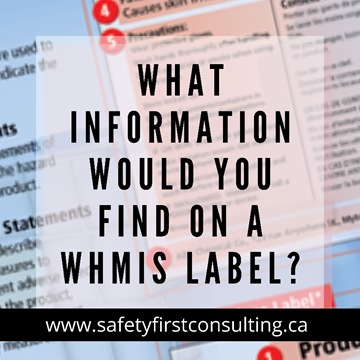
What Information Would You Find on a WHMIS Label?

So, what information would you find on a WHMIS label? There are two different labels, one is the workplace label and the other is the supplier label. On the supplier label, you will find the product name, hazard pictograms, signal words, hazard statements, precautionary statements, and supplier contact information. On the workplace label, the product name is listed, as are safe handling precautions, and a reference to the corresponding safety data sheet (SDS).
If you are looking for online WHMIS training and wish to take our comprehensive online course, please click here to find out more, or read on to find out what info is on a WHMIS label.
Fun Fact: Since the 2015 changes to WHMIS, there shouldn’t be any hazardous products in the workplace with old WHMIS 1988 labels or safety data sheets, it should all be compliant with what is called, “WHMIS 2015”.
Types of WHMIS labels

WHMIS labels are divided into two separate categories: supplier labels and workplace labels. Each label type has specific information requirements. However, the purpose of WHMIS labels is always the same: to flag dangers and outline precautions in the workplace, with reference to the SDS for more details.
WHMIS supplier labels must be done in both official languages in Canada, English and French. Expect to see either a bilingual WHMIS label or two separate labels with one in each language.
The Supplier Label

In most cases, suppliers are responsible for labelling the hazardous products that they provide to customers. Labels should be affixed to, printed/written on, or attached to the hazardous product or the container and remain legible. If it is not legible, raise a concern to your supervisor and request that a new label be provided.
The following are present on a supplier label:
- Product name/identifier
- Pictograms
- Signal Words
- Hazard Statements
- Precautions
- Supplier contact information
Providing a WHMIS 2015 label along with the shipping papers would not be considered to be in compliance.
The Workplace Label

A workplace label is required when a hazardous product is produced (made) at the workplace and used in that workplace, or when a hazardous product is decanted (e.g., transferred or poured) into another container, or a supplier label becomes lost or illegible (unreadable).
Source: CCOHS website
Elements of a workplace label are:
- Product name
- Pictogram
- Precautionary statements
- Reference to SDS
Fun Fact: Employers are responsible for making sure that hazardous products that come into the workplace are labelled and to prepare and apply a workplace label when appropriate.
What info is on a WHMIS Supplier Label?

If an employer receives significant new data from a supplier about a hazardous product, the employer must use this information to update every relevant supplier label as soon as possible (subsection 8(5), WHMIS Reg.).
The employer’s duty complements provisions in the Federal Hazardous Products Act that require a supplier to update labels within 180 days of becoming aware of significant new data about a hazardous product.
Watch this video for a live demonstration of each section:
1. Product Identifier / Product Name
Some essential product identification is included in every WHMIS label, and must be provided in English and French. The common name, brand name, generic name, trade name and chemical name must be clearly indicated.
2. Pictograms

The pictogram is what many people associate with WHMIS labels. This hazard symbol should be contained within a red square set on one of its points. The WHMIS pictogram is designed to clearly indicate the hazard, even to those unfamiliar with the labels. Understanding the WHMIS pictograms must be part of the Ontario health and safety training for those who handle hazardous materials. If you would like us to explain pictograms in more detail, please reach out to us here!
There are ten different WHMIS pictograms:

- Flame symbol
- Flame over circle symbol
- Exploding bomb symbol
- Gas cylinder symbol
- Corrosion symbol
- Skull and crossbones symbol
- Exclamation mark symbol
- Health hazard symbol
- Environment symbol
- Biohazardous infectious materials symbol
Each pictogram contains comprehensive instructions on how to identify and handle the hazardous materials.
3. Signal Words
A signal word is used to alert the reader of the potential hazard. ‘Warning’ is used for low-risk hazards, while ‘Danger’ is used for high-risk hazards. Including one of these two signal words is a WHMIS requirement. If the signal word ties into a hazard class and category, it must be displayed on the label. It must also be listed on the Safety Data Sheet (SDS) under Hazard Identification.
4. Hazard Statement & Precautionary Statement
A hazard statement describes the nature of the hazard posed by the hazardous product. The purpose is to further simplify the identification of hazards. Some potential hazard statements include:
- Causes serious eye damage
- Toxic if swallowed
- Skin corrosion
- Skin irritation
- Acute toxicity
- Extremely flammable gas
- Contains gas under pressure
- May cause cancer
A precautionary statement pulls from a list of standardized phrases. It describes measures to minimize or prevent adverse effects from exposure to the hazardous product. The precautionary statement can also be applied to warn about improper handling or storage of the hazardous product. Examples of precautionary statements include:
- Keep container tightly closed
- Wear protective gloves
- If exposed, get medical attention
- Protect from sunlight
5. Supplemental Label Information
Depending on the product, you may find supplemental information in the WHMIS label. It may include any information on hazards not included within the standardized WHMIS list. Some examples include the physical state, route of exposure, and percentage of ingredients with unknown toxicity. Employers are in charge of making sure every product has a supplier label.
6. Supplier Contact Information
Finally, if you wanted to know what information you would find on a WHMIS label, the supplier of the hazardous material places their contact information at the bottom of it. You will find the supplier’s name, address, phone number, e-mail, fax, or any other contact information that is relevant to contacting the supplier for more information.
What info is on a WHMIS Workplace Label?

A workplace label is required when a hazardous product is created/mixed at the workplace and used in that workplace. A hazardous product is decanted (transferred or poured into another container), or when a supplier label becomes lost or illegible. The label has the product name, pictogram, precautionary statements, and a reminder to check the SDS safety data sheet for more information.
1. Product name
Just like on the supplier label, the product’s name is listed here and matches the workplace label by identifying the common name, the trade name, the chemical name, any name associated with this product for easy identification should be listed here.
2. Pictogram
The pictogram that matches the workplace label is also here, letting you know what kind of hazard class or category you are working with. A pictogram will instantly show the user of the hazardous product what type of hazard they are dealing with i.e. is it flammable or corrosive?
Each graphic symbol has a characteristic red square that is set on one of its corners, except for biohazardous materials. The symbol inside the square represents the hazard, for example, “corrosive” or “flammable”. The red border together with the symbol inside make the whole thing a pictogram.
3. Precautionary statements
This is an important element of what information you can find within a WHMIS label because it tells you advice on handling, storing, first aid instruction, personal protective equipment to wear, and more. The wording of this precautionary statement section is standardized, so workers can become comfortable with the language and recognize it within the workplace. Precautionary statements will be consistent with the degree of the hazard associated with the product.
There are five types of precautionary statements:
- General
- Prevention
- Response (including first aid)
- Storage
- Disposal
Examples of precautionary statements are:
- Keep container tightly closed
- Wear protective gloves/protective clothing/eye protection/face protection
- If exposed or concerned: Get medical advice/attention
- Fight fire remotely due to the risk of explosion
- Protect from sunlight
4. Reference to SDS

Safety data sheets must accompany all products, and the workplace label will reference it. It provides in-depth information about the hazardous product. The SDS is a summary document that provides more information about the hazards of a given product. It also contains additional details about safety precautions.
With your Safety Data Sheet, you will learn the manufacturer’s instructions on storing, how to handle an emergency like a spill, or handling and transporting a product. Click here if you would like to learn more about what should be in a safety data sheet. If you would like to see an example of Ammonia’s SDS, please click here!
In Conclusion, What Information Would You Find on a WHMIS Label?
As we learned above, there are two WHMIS labels with important safety information. The supplier label has the most information on it, and includes: the name of the product, pictograms, signal word, hazard statement, precautions, and supplier contact information. This label is provided by the supplier, in both languages of the country, in our case English and French, and it is mandatory by Federal and Provincial and Territorial laws.
A workplace label is made by an employer and used only in the employer’s workplace. The information requirements for a workplace label are more loose and employers have some flexibility regarding language and format, but it still must contain these items: product name, pictogram, precautionary statements, and reference to see the corresponding SDS sheet.
Did you know that WHMIS must be completed yearly? Contact us here for more information or click here to register now for our online WHMIS training, we provide group and individual access to receive an official WHMIS certificate from Safety First Consulting.

